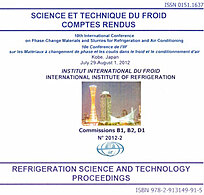
Document IIF
Étude sur la conductivité thermique réelle d'un matériau à changement de phase à forme stable grâce à la théorie des cavités de géométrie fractale.
Study on effective thermal conductivity of form-stable phase change material by fractal-cavity theory.
Numéro : pap. P02
Auteurs : DAI X., CHEN Z. Q.
Résumé
In order to predict better effective thermal conductivity of form-stable phase change material (PCM), high density polyethylene (HDPE)/paraffin composites are studied in the paper. Based on the fractal theory, it describes the pore microstructure when the paraffin is extracted, and the volume change in phase transformation of paraffin and the cavity caused by manufacturing technology are also considered. Hence fractal-cavity model is established which includes fractal dimension, cavity ratio, volume shrinkage rate, porosity, and so on. The heat conduction model can prove to be well in reflecting the relation between thermal properties of the form-stable PCM and its true internal structure. The theoretical results are also agreed well with those of experiments. Furthermore, the influence of the several significant parameters on the effective thermal conductivity has been analyzed in the paper. The conclusion would have important guidance significance for the application of the form-stable PCM.
Documents disponibles
Format PDF
Pages : 9 p.
Disponible
Prix public
20 €
Prix membre*
Gratuit
* meilleur tarif applicable selon le type d'adhésion (voir le détail des avantages des adhésions individuelles et collectives)
Détails
- Titre original : Study on effective thermal conductivity of form-stable phase change material by fractal-cavity theory.
- Identifiant de la fiche : 30005097
- Langues : Anglais
- Source : 10th International Conference on Phase-Change Materials and Slurries for Refrigeration and Air Conditioning. Proceedings: Kobe, Japan, July 29-August 1, 2012.
- Date d'édition : 01/07/2012
Liens
Voir d'autres communications du même compte rendu (46)
Voir le compte rendu de la conférence
Indexation
-
Preparation of enhanced PCM/diatomite composite...
- Auteurs : JEONG S. G., LEE J. H., JO J. H., et al.
- Date : 16/06/2013
- Langues : Anglais
- Source : Clima 2013. 11th REHVA World Congress and 8th International Conference on Indoor Air Quality, Ventilation and Energy Conservation in Buildings.
- Formats : PDF
Voir la fiche
-
Development of phase change material containing...
- Auteurs : CHOI D. H., KIM J. Y., KANG Y. T.
- Date : 25/06/2012
- Langues : Anglais
- Source : 10th IIR-Gustav Lorentzen Conference on Natural Working Fluids (GL2012). Proceedings. Delft, The Netherlands, June 25-27, 2012.
- Formats : PDF
Voir la fiche
-
Measurement of thermal conductivity of TBAB CHS...
- Auteurs : ZHANG P., MA Z. W.
- Date : 01/07/2012
- Langues : Anglais
- Source : 10th International Conference on Phase-Change Materials and Slurries for Refrigeration and Air Conditioning. Proceedings: Kobe, Japan, July 29-August 1, 2012.
- Formats : PDF
Voir la fiche
-
Latent heat transportation system using direct-...
- Auteurs : NOMURA T., TSUBOTA M., OKINAKA N., et al.
- Date : 01/07/2012
- Langues : Anglais
- Source : 10th International Conference on Phase-Change Materials and Slurries for Refrigeration and Air Conditioning. Proceedings: Kobe, Japan, July 29-August 1, 2012.
- Formats : PDF
Voir la fiche
-
Development of PCM containing MWCNT for heat st...
- Auteurs : CHOI D. H., KIM Y. J., PARK N., et al.
- Date : 01/07/2012
- Langues : Anglais
- Source : 10th International Conference on Phase-Change Materials and Slurries for Refrigeration and Air Conditioning. Proceedings: Kobe, Japan, July 29-August 1, 2012.
- Formats : PDF
Voir la fiche
